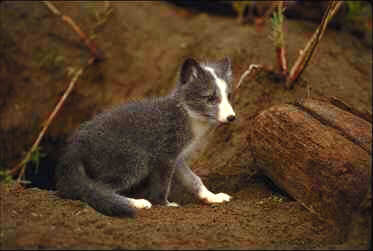
 |
| An arctic fox kit. |
Arctic foxes generally mate with only one partner per season, and a certain degree of monogamy between breeding seasons has been noted. During courtship, a couple playfully chases and tussles with one another. Females come into heat between February and April for a period of up to two weeks. Gestation averages 52 days but may vary between 51-57 days.
Arctic foxes don´t usually use dens for most of the year. Prior to giving birth, however, a natal den is prepared. It is usually built into the side of a ridge or esker, in a snow bank, or in a rock pile. In some cases, the dens are visible as mounds of up to 4m in height on open tundra. An established den typically has four to twelve openings, while very old dens may have up to a hundred. Several of these dens may occur in a given area, and many have been passed down from one generation to the next for centuries.
The offspring are born between May and June. Litter size varies widely depending on the health of the mother (due to food availability) and can be quite large, between two and twenty-five pups. Six to twelve pups is considered the norm, and the average mass at birth is 57g. Despite being cared for by both parents, many of the kits do not survive to reach adulthood. When food is sparse, strong kits will cannibalize their weaker siblings, and in extreme shortages the parents will abandon their young. The pups are also occasionally preyed on by eagles, wolves, and grizzly bears. Weaning occurs between the second and fourth week, and full adulthood is reached by their tenth month.
Because they are dependent on the lemming for food, arctic fox populations exhibit similar population cycles. The Canadian Wildlife Service´s publication on arctic foxes mentions that the lemming population can be subject to a ten to twenty-fold increase from one year to the next, and is subject to a one hundred-fold decline at the end of its cycle. Foxes gradually increase their numbers only to experience a similar decline during these crashes. These events frequently trigger the migrations mentioned earlier.
Although captive arctic foxes can live up to fifteen years in captivity, such longevity is unheard of in the wild. Predation from other animals, trapping by humans, and harsh arctic conditions are the chief factors in mortality. Most kits die before six months of age, and few adults survive past two years.
| Table of Contents |